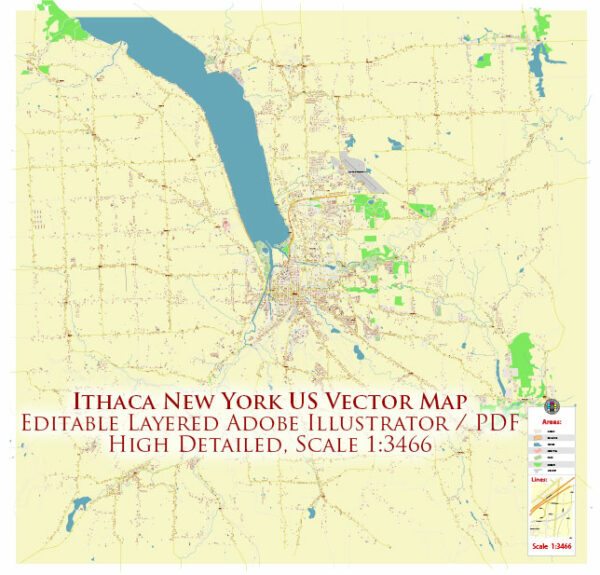Ithaca, located in upstate New York, has a rich industrial history and a well-developed road system.
Vectormap.Net provide you with the most accurate and up-to-date vector maps in Adobe Illustrator, PDF and other formats, designed for editing and printing. Please read the vector map descriptions carefully.
Let’s delve into each aspect:
Industrial History:
- Early Industries (19th Century):
- Ithaca’s industrial history dates back to the 19th century when it was a thriving center for milling and manufacturing.
- Water-powered mills along the Cascadilla Creek were crucial to the early development, supporting industries like flour milling, sawmills, and textile production.
- Wharton School (Late 19th Century):
- Ithaca became home to the Wharton School of Finance and Economy, which later moved to the University of Pennsylvania. The school played a role in shaping business education in the United States.
- Glaciarium (Early 20th Century):
- The invention of the first mechanically refrigerated ice rink, known as the Glaciarium, was a notable industrial development in the early 20th century. It was designed and built in Ithaca by Frank and George Boland.
- Cornell University’s Influence:
- Cornell University, established in 1865, has been a significant influence on Ithaca’s industrial landscape. The university has fostered research and innovation, leading to spin-off industries and technology transfer.
- Tompkins County Library (1930s):
- The construction of the Tompkins County Library in the 1930s is an example of Depression-era public works projects. It stands as a testament to the community’s commitment to education and culture.
- High-Tech and Research (Late 20th Century – Present):
- With Cornell University and Ithaca College as anchors, the region has evolved into a hub for high-tech and research industries. This includes biotechnology, nanotechnology, and other cutting-edge fields.
Road System:
- Infrastructure Development:
- Ithaca’s road system has evolved over the years to accommodate the growing population and industrial activities.
- The construction of major highways, including New York State Route 13 and New York State Route 34, has played a crucial role in connecting Ithaca to the rest of the state.
- Cayuga Lake Scenic Byway:
- The Cayuga Lake Scenic Byway offers a picturesque route around Cayuga Lake, providing breathtaking views of the lake and surrounding landscapes. It’s a popular drive for both residents and tourists.
- Public Transportation:
- Ithaca is served by the Tompkins Consolidated Area Transit (TCAT), which provides bus services connecting various parts of the city and surrounding areas.
- Bridges:
- Several bridges span the gorges in and around Ithaca, providing important transportation links. These include bridges over Cascadilla Creek, Fall Creek, and other water bodies.
- Traffic Management:
- As a university town with a significant student population, Ithaca experiences traffic variations based on the academic calendar. Traffic management initiatives aim to balance the needs of residents, students, and businesses.
In summary, Ithaca’s industrial history has been shaped by milling, manufacturing, and the influence of educational institutions like Cornell University. The road system has adapted to support the region’s growth, connecting Ithaca to the wider network of highways and scenic routes.


 Author: Kirill Shrayber, Ph.D.
Author: Kirill Shrayber, Ph.D.